STOP FROZEN WATERERS
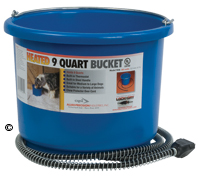
Strong steel handles don’t become brittle (like plastic handles) in cold temperatures.
Heated Buckets
For watering livestock and pets in winter months. Keeps water from freezing.
Wire spring protects cord to prevent damage from animal’s teeth.
Built-in thermostat turns bucket’s heater on at 40ºF and off at 60ºF.
6 ft cord. 1 year warranty.
We offer the following:
Also available from Premier—Feeding Buckets.
USEFUL COLD WEATHER TOOL
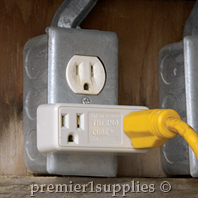 ThermoCube
ThermoCube
Saves electricity $$.
Quickly repays initial cost.
Automatically turns power on and off according to air temperature around the cube—on at less than approximately 35ºF and off at 45ºF.
To use, plug it into an outlet, and then plug heat lamps, buckets, engine block heaters, etc. into ThermoCube.
DE-ICERS
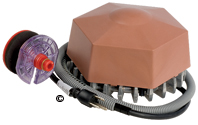 3-in-1 De-Icer
3-in-1 De-Icer
Unique because it can be changed to float or sit on the tank bottom. Patented design allows electrical cord, if you wish, to pass out through the tank’s drain plug for better protection.
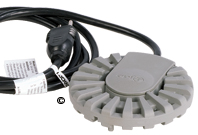 Bucket De-Icer
Bucket De-Icer
Sits inside at bottom of buckets or small water tanks. Built-in thermostat turns on at 40ºF and off at 60ºF.
|
 |
 |
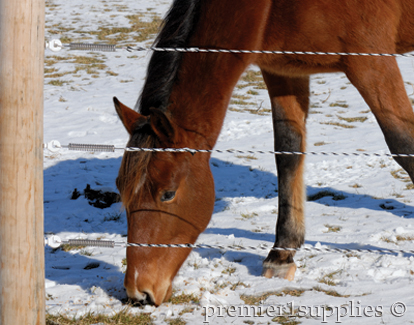
An effective fence for horses does not need to involve HT wire. Instead, a few strands of IntelliRope®, some TuffRings™ II and P Springs are all that is needed to effectively and safely contain horses.
Winter Feed & Water for Horses
How much should horses be eating and drinking during the winter months? Please enjoy the articles below detailing the importance of water consumption and hay quality for our equine friends.
EXTENSION NEWS
Hay Testing and Understanding Forage Quality
By Dr. Rocky Lemus, Assistant Extension Professor, Plant and Soil Sciences, Mississippi State University Extension Service
Do you wonder if your hay is of the highest quality? Forage testing assesses the nutrient composition of forages, allowing ranchers to develop feeding programs and commercial hay producers to develop marketing strategies. Because hay and other stored forages play a major role in winter-feeding programs, testing hay now will provide producers with enough time to design a good feeding program that optimizes hay usefulness and livestock performance. Forage testing provides accurate information about its nutritive value. Testing can tell you how to adjust the amount of protein and energy supplements necessary to meet animal requirements.
Forage quality is defined as the potential of forage to produce a desired animal response. It involves consumption, nutritional value, and the resulting animal performance. Hay quality includes palatability, digestibility, intake, nutrient content, and anti-quality factors. The primary reason for livestock producers to test their hay is to increase their net profit. Not knowing the forage’s nutrient composition might cause the producer to underestimate or overestimate nutrient requirements and cut profitability.
How To Collect a Hay Sample
Producers should routinely get a representative sample for hay analysis because forage quality can change based on forage species and mixtures (Table 1), maturity, management, harvest and storage conditions, rain damage, and insect or disease damage. When sampling hay lots, sample each hay lot separately. A hay lot is defined as hay from the same field, same cutting, harvested under the same environmental conditions, and having a uniform forage composition (grass or legume only, or grass/legume mixture).
To determine the quality of the hay accurately, a representative sample must be taken using a hay probe (Table 2). Use a hay probe that is 12 to 24 inches long and 3/8 to 5/8 inches in diameter. Grabbing and pulling hay from different bales is not the correct method, and it will not provide uniform samples for analysis. Producers should sample 15 to 20 round bales depending on the number of bales in the lot, and samples should be taken from the round edge of the bale. For example, if sampling a hay lot that contains 300 bales, sample every fifteenth bale to obtain a representative sample of the entire lot. If the outer layer of the bale has deteriorated, remove the outer layer (usually several inches) before sampling to avoid collecting material that will skew the analysis.
For pastures that will be grazed, samples should be obtained directly from the standing forage in the field. These samples should be taken shortly before the livestock are turned into a pasture. The producers should walk over the entire field and collect 30 to 50 random small grab samples per each 5 acres. Grab samples are taken by reaching down and grabbing a small section of forage between the thumb and forefinger at the same height that the livestock will graze the pasture.
Avoid collecting samples in areas that have high weed infestation or areas that have high concentrations of legumes or grass.
Read More »
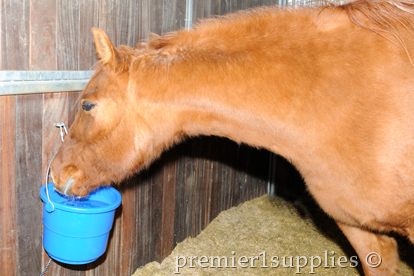
Keep a constant supply of water in front of your horse. If using smaller buckets (such as the one shown, which is our Heated Flat Back Bucket, 2.5 gallon) refill multiple times throughout the day.
EXTENSION NEWS
Winter Water for Horses
Susan Garey, Extension Agent with University of Delaware Cooperative Extension
December 5, 2012 in Advice and Tips, General
Horse owners and caretakers pay careful attention to the quantity and quality of water that horses consume during the hot summer months. However, water consumption during the winter months is just as critical to our horses’ health.
The body of an adult horse is approximately 62-68% water (about 70% water in foals). Proper hydration is essential to the horse’s fluid balance. Among the most important considerations for adequate water consumption is water’s role in keeping the horse’s digestive tract moving and functioning properly. Adequate winter-water intake can reduce the risk of impaction colic. The occurrence of colic increases between December and March, mainly because horses don’t drink enough water in winter months (Swinker, 2012).
We can help our horses maintain adequate hydration in the winter by providing them with plenty of clean, fresh water that is the proper temperature. Research conducted at the University of Pennsylvania during cold weather in the mid 1990’s demonstrated the effects of water temperature on water consumption in horses. This research showed that during cold weather, horses offered warm water consume significantly more water (as much as a 40% increase) than if they were offered only ambient, near freezing water.
Heated buckets and stock tank heaters are good options to help keep your water temperature warm in the winter and encourage horses to drink. For owners who have 3- 5 horses, providing a heated bucket or tank heater is certainly less expensive than the cost of one vet call to treat an impaction colic. Remember that stock tank heaters should be plugged into a GFCI protected outlet to prevent your horse from potentially getting shocked. Generally speaking the plug type stock tank heaters are safer than the floating style, especially in a plastic tank. If you have a horse that likes to paw in its water tank even in the dead of winter, you may need to install a plywood lid to limit access or a metal grate that sits over the plug heating element to protect it from being damaged or broken.
If tank heaters and water bucket heaters aren’t an option for your management system, then consider another interesting observation that resulted from the University of Pennsylvania drinking water temperature study. Researchers observed that stalled horses in the study that were fed hay and grain tended to do most of their drinking within 3 hours after feeding. Knowing this implies the necessity to coordinate your watering to coincide with this period of time when horses tend to consume the most water. This will also allow you to keep the water temperature warmer than if it is left sitting in the bucket or tank all day long.
During the winter months, as recommended during other times of the year, water should always be available to ensure the horse’s daily maintenance water requirement of 8-10 gallons is met. This means horses housed in stalls should have access to two, 5 gallon buckets. Additionally, a stock tank needs to be large enough to comfortably provide each horse it serves with a minimum of 10 gallons of water per horse.
An easy way to warm up stall water buckets is to carry gallon jugs full of very hot water from your house and add it to the bucket [or tank] water, remembering to always warm both buckets. Warming stall water has an especially profound positive effect for our older horses.
Further recommendations to help keep your horses properly hydrated in winter months include providing free choice salt, and feeding a diet that is largely forage based. Free-choice access to a trace mineral or salt block will increase water consumption. High forage diets contain more water than a diet that is mainly grain based. However, harvested forages such as hay are drier than pasture grasses, and therefore adequate water consumption is extremely important during this time of year when horses are being transitioned from a diet consisting primarily of pasture to a hay-based diet. The transition between forage in the diet provided by pasture and forage provided by hay should occur gradually. Changes in the variety or type of hay being fed also need to be made gradually to reduce the risk of digestive disturbances.
Additional Winter Management Tips:
| 1. |
Make sure your horses are in adequate body condition going into the winter. It is much harder to put weight on a horse during the winter months. |
| 2. |
Keep a close watch on your horse’s body condition. With heavy winter coats, a visual inspection is not enough. Make sure you run your hands over your horse to feel for ribs. |
| 3. |
Provide plenty of good quality forage to your horse. Digesting forage takes longer and actually produces more body heat for a horse than digesting grain. The average 1,000 lb. horse that receives the majority of their ration as hay should be fed about 20 lbs. of hay per day. |
| 4. |
Provide free choice plain white salt. |
| 5. |
Don’t lock the barn up tight. Make sure that there is adequate ventilation so you aren’t trapping ammonia and disease organisms in with your horses. |
| 6. |
If you blanket your horses, make sure that you remove the blankets and check their body condition regularly. Check blankets for proper fit and damage and make any necessary adjustments and repairs immediately. Check your horse(s) regularly to make sure blankets are not creating rubs or sores. |
| 7. |
We tend to have mud in the winter on theDelmarva Peninsula. Pick hooves regularly so that frogs have a chance to dry out and reduce your risk of thrush. Chronic mud on a horse’s legs can result in bacterial or fungal infections such as scratches. Also be sure to remove ice buildup from your horse’s feet. |
| 8. |
Keep your horses as clean and dry as possible to reduce the risk of developing scratches or rain rot. |
| 9. |
Have a plan to deal with the potential loss of electricity on your farm due to a snow or ice storm. If water on your farm is provided from a well, do you have a back-up water source should you lose power? |
Resources and further reading:
Kristula, M.A. and McDonnell, S.M. Drinking Water Temperature Affects Consumption of Water During Cold Weather in Ponies. Journal of Applied Animal Behavior Science. Volume 41, issues 3-4, August 1994. pp. 155-160.
Swinker, A., In Cold Weather Horses Will Reduce Water Consumption and Be At Risk of Colic. Equine News. Pennsylvania State University Cooperative Extension. November 2012.
|
|